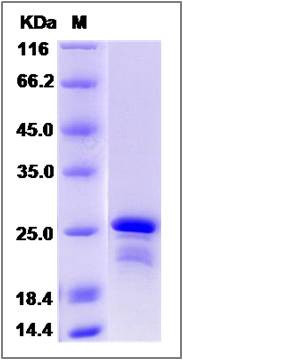Human CBFB / CBF-beta Protein (His Tag)
PEBP2B
- 100ug (NPP3650) Please inquiry
| Catalog Number | P14569-H07E |
|---|---|
| Organism Species | Human |
| Host | E. coli |
| Synonyms | PEBP2B |
| Molecular Weight | The recombinant human CBFB consists of 197 amino acids and predicts a molecular mass of 23.3 KDa. It migrates as an approximately 27 KDa band in SDS-PAGE under reducing conditions. |
| predicted N | His |
| SDS-PAGE |  |
| Purity | > 85 % as determined by SDS-PAGE |
| Protein Construction | A DNA sequence encoding the mature form of human CBFB (Q13951-1) (Met1-Pro182) was expressed with a polyhistidine tag at the N-terminus. |
| Bio-activity | |
| Research Area | Epigenetics |Transcription |Other factors |
| Formulation | Lyophilized from sterile PBS, pH 7.4. 1. Normally 5 % - 8 % trehalose, mannitol and 0.01% Tween80 are added as protectants before lyophilization. Specific concentrations are included in the hardcopy of COA. |
| Background | CBFB is the beta subunit of a heterodimeric core-binding transcription factor belonging to the PEBP2/CBF transcription factor family which master-regulates a host of genes specific to hematopoiesis (e.g., RUNX1) and osteogenesis (e.g., RUNX2). CBFB is a non-DNA binding regulatory subunit; it allosterically enhances DNA binding by alpha subunit as the complex binds to the core site of various enhancers and promoters, including murine leukemia virus, polyomavirus enhancer, T-cell receptor enhancers and GM-CSF promoters. Alternative splicing generates two mRNA variants, each encoding a distinct carboxyl terminus. In some cases, a pericentric inversion of chromosome 16 [inv(16)(p13q22)] produces a chimeric transcript consisting of the N terminus of core-binding factor beta in a fusion with the C-terminal portion of the smooth muscle myosin heavy chain 11. This chromosomal rearrangement is associated with acute myeloid leukemia of the M4Eo subtype. Two transcript variants encoding different isoforms have been found for CBFB gene. Mutations in CBFB are implicated in cases of breast cancer. |
| Reference |
